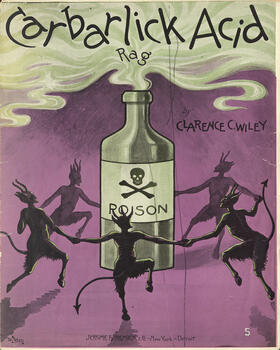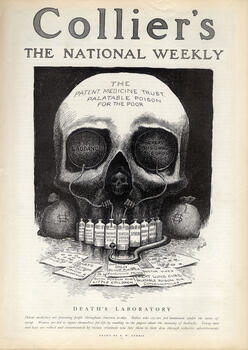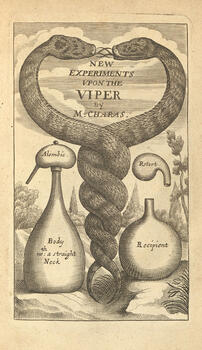On display in the Cushing Rotunda, March 22 - August 13, 2023
A touchstone of murder mysteries and historical intrigue, tactical warfare and political coups, poison looms large in our cultural imagination. An invisible agent of death, it might be hiding anywhere, stashed in a secret agent’s suitcase or mixed into a murderous martini.
This exhibit traces major developments in medical, legal, and public knowledge of poisons in America as they have been used for both good and ill. Looking back through the lore of classical antiquity turns up mythical poisons and their antidotes: the paralytic stare of the cockatrice; the salvific unicorn horn. Poison plants and venomous vipers found fame in the ancient world as well (Socrates was supposedly poisoned by hemlock; Cleopatra by an asp)--though illustrated 19th century herbals, early 20th century pharmaceutical guides, and even 21st century textbooks underscore how many of these same toxins can also be used in life-saving medications. Other exhibit highlights include food adulteration and household poisons, developments in forensic toxicology, and even a 19th century New Haven murder trial. From cartoons and campy tunes to labwork and legal testimony, poison is everywhere–come see!
Curated by Sophia Richardson, doctoral candidate in English, Graduate School for Arts and Sciences 2022 curatorial fellow, with the assistance of Dr. Melissa Grafe and the staff at the Yale Medical Historical Library.
For a current look at poisoning today, take a look at this blog post Data Librarian Kaitlin Throgmorton developed in conjunction with the exhibition and National Poison Control Week.
Image descriptions:
-
Cover from Clarence C. Wiley’s Carbarlick Acid Rag. Printed by Jerome H. Remick & Co., 1905. Sheet music collection on medical themes. Gift of William Helfand, 2013.
-
“Death’s Laboratory.” Cover of Collier’s Magazine. 3 June 1905. Reproduction from Manuscripts and Archives, Yale University
-
Plate featuring the foxglove plant from William Withering’s An account of the foxglove, and some of its medical uses : with practical remarks on dropsy, and other diseases. Birmingham (England): Printed by M. Swinney, for G. G. J. and J. Robinson, London, 1785.
- Title page from Moyse Charas's New experiments upon vipers. Containing also an exact description of all the parts of a viper, the seat of its poyson, and the several effects thereof…London: Printed for J. Martyn, 1673.




